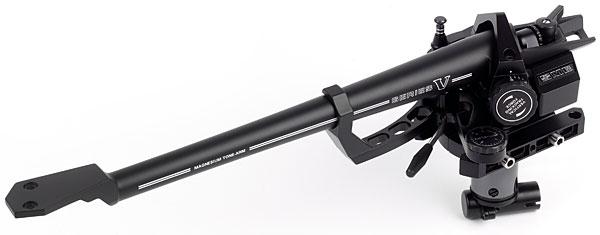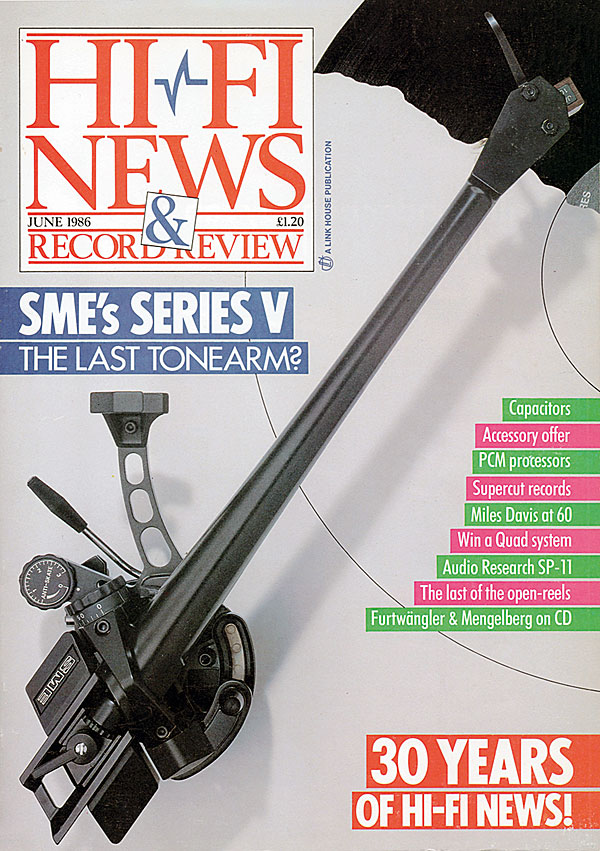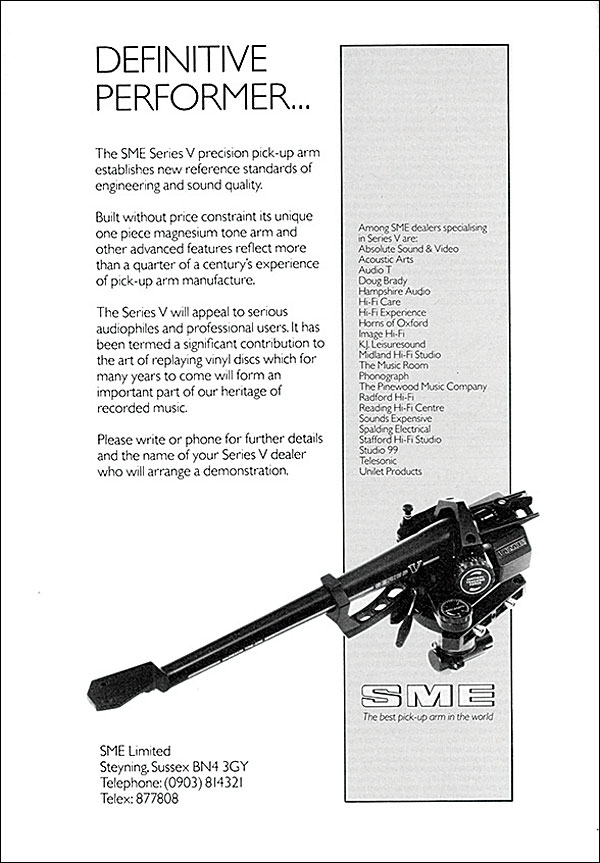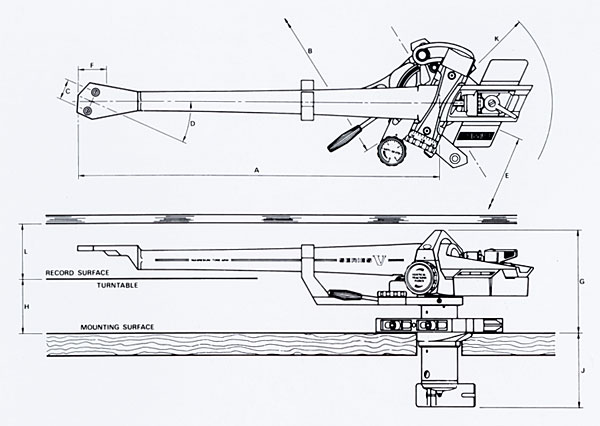The World's Best Tonearm?

The Series V tonearm is on sale at last, albeit in limited quantities. The fruit of many years of creative research, a handmade prototype 'V' was shown to prospective distributors at the American and German shows two years ago, but it has taken a long time to get the arm into production. Components were continually tried from prospective suppliers until the quality was right and when first shown in 1984, the price was targeted at what was then a very high level, at £750 or so. Some expressed doubts concerning its credibility at that price, indeed of any similarly-priced tonearm.
The price has risen above the initial target and now it is available, the 'V' sells for nearly £1200, which is an eye-watering price for a tonearm. However, its stake on SME's traditional claim, 'The best tonearm in the world', is supported by an exceptional standard of design – technology, engineering and aesthetics – directed towards versatility, compatibility, but above all, sheer performance.

A medium-to-high mass arm, with a 10-11g effective mass, its use of materials has been optimised to provide maximum structural resonance control and rigidity. The latter is essential to hold the cartridge firmly so that as much musical groove information as possible is transformed to its electrical equivalent and fed to the preamp. Satisfying this requirement for rigidity and simultaneously allowing for the cartridge to move freely in two axes is a major problem which all arm designers have to solve. Their skill in finding a solution that remains consistent in production largely determines how well the arm will perform subjectively in the real world.
Freedom Calls
To quote SME in its excellent instruction manual for the 'V': 'In theoretical terms an ideal pick-up arm is supposed to be perfectly unyielding in four out of six possible degrees of freedom. That is, all except the two linear dimensions in which the music signal is generated by groove modulation. In those two linear dimensions, an ideal arm is supposed to act as a pure mass'.
SME does not claim to have achieved this. Rather, it believes that it has approached closer to this paradigm with the 'V' than with its previous models. 'Pure Mass' implies that no compliance or potential for flexure exists. If realised, such an arm would be totally non-resonant, except at subsonic frequencies, and would be devoid of frequency imbalance or coloration.
Arms typically exhibit flexure in several parts of the structure, sometimes at surprisingly low frequencies. Detachable headshell models generally 'sing' between 200Hz and 300Hz due to the headshell/arm joint. Meanwhile, arms with decoupled counterweights can run into trouble at frequencies as low as 50Hz. Poorly designed main beams, or for that matter bearing assemblies, can introduce a series of resonances from a few hundred Hertz upwards.

The Linn lttok LVII is an early classic design which has stood the test of time. lt avoids most pitfalls, and has been the model for later designs. The Swiss Breuer predated the lttok, but was always regarded as too costly – little would we have guessed that the ultimate SME would cost very much more!
The new SME arm aims to solve a major headache in one bold stroke, one already partially addressed by Roy Gandy in his Rega RB300. This is to remove all the usual bonds between headshell and armtube, tube and pivot assembly, assembly and counterweight. By doing this, a number of potential weaknesses are eliminated. The SME designer chose to make the main beam a massive-looking affair of heavily-tapered, relatively thin-wall, magnesium alloy, cast in one piece with the substantial cartridge mounting platform, bearing assembly and the rear gantry and track for the counterweight. The large diameter of the cast beam maximises the torsional stiffness, while the strong taper to the headshell exerts a firm grip on any possible bending vibration modes.
Bearing Down
Following various reports obtained during prototype testing, it was decided that the counterweight be clamped tightly in position after alignment, eschewing the rubber coupling often employed to try to lower the amplitude of midband resonances. In the event, such compromised damping was not required. Ideally, the counterweight material should be of high density, allowing its mass to be concentrated physically to allow placement close to the pivot/bearing position. This minimises self resonance and lowers its contribution to the effective mass, allowing more mass to be used to reinforce the main arm beam. To help realise this goal, SME chose to employ a tungsten block, optimally dimensioned. (In fact Rega also uses tungsten for the counterweight of its RB300.)
In its previous designs, SME aimed at providing very low bearing friction in the two required planes of motion, employing a small precision ball race for the horizontal motion and a gravity loaded knife-edge bearing for the vertical. Recognising that lower compliance cartridges impart significant acceleration to the arm, SME resolved to use ballrace bearings for both planes. In the case of inexpensive designs, these are generally left on the slack side to ensure low friction. Any trace of play, however, can have dire subjective consequences, the general effect being a grainy imprecision in the treble, an additional degree of sibilance on vocals, and in some cases a brittle brightness at high frequencies.
The SME Series V, as with other great tonearms, had to be devoid of any play. However, strong bearings require a degree of pre-load tension to take up any slackness and stiffen the operating assembly. To sustain these forces without any brinelling, or indentation, of the bearing surfaces, high-load, large-size. stainless steel ball race assemblies from Switzerland are used.

In harmony with these strong bearings, the whole pivot assembly, yoke and pillar, are substantial in size so as not to prejudice the overall rigidity. A lathe-like double-jaw clamp locks the pillar into a pair of guides which run between the main mounting bars of the bedplate. Once the arm has been positioned after lateral stylus overhang and height alignment, the whole assembly is locked together with a socket wrench. A rack and pinion drive allows overhang adjustment.
This rigid construction means that a substantial degree of audio range energy from the cartridge is communicated to the arm baseplate and hence to the turntable chassis, an important point which will be considered later. This may strongly affect the ideal choice of turntable.
Bolt From The Blue
Nominally compatible with the earlier SME arm baseplates, the fixing centres for the four screws and the familiar oval arm board cutout are the same. Thereafter, some differences emerge. Unlike its predecessors, which used a compliant rubber grommet mounting, the 'V' is rigidly bolted to the turntable, and the through bolts need clearance below the chassis. Care must be taken with the Linn LP12, for example. Another minor difficulty concerns the current LP12's corner plinth reinforcements in that the one nearest the tonearm fouls the 'V's leadout assembly and needs careful paring away.
At this point it would be appropriate to discuss the basic specification of the arm. Intended to be compatible dimensionally with earlier SME models, the 'V' is a rigidly-pivoted design with a 233.15mm stylus-to-pivot distance, and a 23.635o offset angle. Fixed locating centres are provided for the cartridge, overhang or lateral alignment being accomplished by moving the arm on its bedplate. Even though the 'V' is massively constructed, it is relatively compact and will fit turntables with normal internal lid clearances.
The line drawings [see left] give a good idea of the tonearm's mechanical construction. Note the right-angle exit for the leadout socket, a viscously damped joint which will rotate itself to a convenient point determined by the cable. This simplifies cable dressing with subchassis turntables. No provision is made for headshell rotation or azimuth adjustment, the cartridge mounting plate being set parallel with the record surface. As a consequence of the offset angle, a slight degree of vertical rotation may be applied by altering the height adjustment.
























































